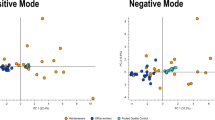Abstract
Purpose
To determine whether the occupational exposure of hairdressers to permanent hair dyes can be quantified by the use of biological monitoring of urinary aromatic diamines as one of the main constituents and to compare these levels to those recently determined in persons after personal application of hair dyes.
Methods
Fifty-two hairdressers (40 female and 12 male) from 16 hairdresser salons in and around the city of Aachen took part in this field study. Subjects were asked to document all operations associated with possible exposure to permanent hair dyes like mixing colour, application of colour, washing after dyeing, and cutting of freshly coloured hair. Excretion of aromatic diamines 2,5-toluylene diamine (2,5-TDA) and p-phenylene diamine (p-PDA) as main constituents of commercially available hair dyes was measured in urine samples using a highly specific and accurate GC/MS-method. Urine samples were taken at 5 points of time during the work week: pre-shift before the start of the work week, pre- and post-shift on the third day of the work week and finally pre- and post-shift on the last day of a work week in order to meet different workloads and possible accumulative effects over the week. Nineteen persons matched for age served as a control group and gave spot urine samples.
Results
Although the levels were generally low, we could determine a significantly higher internal exposure to 2,5-TDA in hairdressers (medians ranged from <0.2 μg/g creatinine up to 1.7 μg/g creatinine at various sampling times, with a maximum of 155.8 μg/g creatinine) compared to the control group (median <0.2 μg/g creatinine, maximum 3.33 μg/g creatinine). At the same time, p-PDA was detectable only in selected cases in the group of hairdressers but not in the control group. Overall, there was neither an intra-shift effect seen nor an effect across the work week. There was also no significant difference in urinary excretion of participants who reported wearing protective gloves compared to those who reported not wearing protective gloves.
Conclusion
The internal exposure to aromatic diamines in hairdressers using permanent hair dyes can be determined using biological monitoring. The extent of exposure is low compared to subjects after personal application of hair dyes, who excreted more than 200 times higher amounts of aromatic diamines. This slight work-related exposure might be reduced by the strict adherence to the use of suitable gloves as well as long-sleeved clothing.



Similar content being viewed by others
References
Bolt HM, Golka K (2007) The debate on carcinogenicity of permanent hair dyes: new insights. Crit Rev Toxicol 37(6):521–536
Czene K, Tiikkaja S, Hemminki K (2003) Cancer risks in hairdressers: assessment of carcinogenicity of hair dyes and gels. Int J Cancer 105:108–112
DFG (Deutsche Forschungsgemeinschaft) (2009) List of MAK- and BAT-values 2009. Wiley-VCH, Weinheim
Dryson E, `t Mannetje A, Walls C, McLean D, McKenzie F, Maule M, Cheng S, Cunningham C, Kromhout H, Boffetta P, Blair A, Pearce N (2008) Case control study of high risk occupations for bladder cancer in New Zealand. Int J Cancer 122:1340–1346
Gaertner RR, Trpeski L, Johnson KC, CanadianCancerRegistriesEpidemiologyResearch Group (2004) A case-control study of occupational risk factors for bladder cancer in Canada. Cancer Causes Control 15:1007–1019
Gago-Dominguez M, Castelao JE, Yuan JM, Yu MC, Ross RK (2001) Use of permanent hair dyes and bladder-cancer risk. Int J Cancer 91:575–579
Hueber-Becker F, Nohynek GJ, Meuling WJA, Benech-Kieffer F, Toutain H (2004) Human systemic exposure to a [14C]-para-phenylenediamine containing oxidative hair dye and correlation with in vitro percutaneous absorption in human or pig skin. Food Chem Toxicol 42:1227–1236
International Agency for Research on Cancer (IARC) (1993) Occupational exposures of hairdressers and barbers and personal use of hair colourants; some hair dyes, cosmetic colourants, industrial dyestuffs and aromatic amines. IARC Monograph Eval Carcinog Risks Hum 57:43–118
Larsen K (1972) Creatinine assay by a reaction-kinetic principle. Clin Chim Acta 41:209–217
Lin J, Dinney CP, Grossman HB, Wu X (2006) Personal permanent hair dye use is not associated with bladder cancer risk: evidence from a case-control study. Cancer Epidemiol Biomarkers Prev 15:1746–1749
Meyer A, Blömeke B, Fischer K (2009) Determination of p-phenylenediamine and its metabolites MAPPD and DAPPD in biological samples using HPLC-DAD and amperometric detection. J Chromatogr B 877:1627–1633
Rollison DE, Helzlsouer KJ, Pinney SM (2006) Personal hair dye use and cancer: a systematic literature review and evaluation of exposure assessment in studies published since 1992. J Toxicol Environ Health B Crit Rev 9:413–439
Schettgen T, Musiol A, Gube M, Kraus T (2008) Biomonitoring aromatischer Diamine und aromatischer Amine im Urin nach der Anwendung von Oxidationshaarfarben. In: Baur X, Glensk E (eds) Verhandlungen der Deutschen Gesellschaft für Arbeits—und Umweltmedizin (DGAUM), 48. Jahrestagung. Gentner Verlag, Stuttgart, pp 497–502
Schettgen T, Heinrich K, Kraus T, Gube M (2010) Determination of 2,5-toluylendiamine (2,5-TDA) and aromatic amines in urine after personal application of hair dyes—kinetics and doses. Arch Toxicol (submitted)
Skarping G, Brorson T, Sangö C (1990) Biological monitoring of isocyanates and related amines. Int Arch Occup Environ Health 63:83–88
Stanley LA, Skare JA, Doyle E, Powrie R, D’Angelo D, Elcombe CR (2005) Lack of evidence for metabolism of p-phenylenediamine by human hepatic cytochrome P 450 enzymes. Toxicology 210:147–157
Acknowledgments
The authors would like to express their deepest gratitude to all study participants for their interest in this study that demanded high personal commitment and labour. Furthermore, Ms. Kerstin Gerards is acknowledged for her skilful analysis of urinary creatinine and Mrs. Kathy Bischof for her editorial assistance.
Conflict of interest statement
The authors declare that they have no conflict of interest.
Author information
Authors and Affiliations
Corresponding author
Rights and permissions
About this article
Cite this article
Gube, M., Heinrich, K., Dewes, P. et al. Internal exposure of hairdressers to permanent hair dyes: a biomonitoring study using urinary aromatic diamines as biomarkers of exposure. Int Arch Occup Environ Health 84, 287–292 (2011). https://doi.org/10.1007/s00420-010-0539-x
Received:
Accepted:
Published:
Issue Date:
DOI: https://doi.org/10.1007/s00420-010-0539-x




